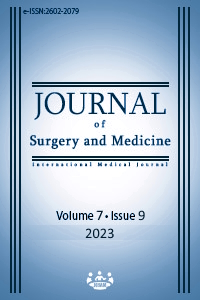Musculoskeletal injuries profile of patients applying to a sports medicine outpatient clinic
Musculoskeleteal injuries in sports medicine
Keywords:
athletic injuries, classification, injuries, musculoskeletal system, sports medicineAbstract
Background/Aim: Sports injuries represent a significant public health concern, and their prevalence is on the rise due to the growing global population and increased participation in amateur and professional sports. Epidemiological studies on sports injuries are crucial in identifying priority areas for injury prevention efforts. While there is a wealth of research on musculoskeletal injuries specific to various sports, there is a scarcity of epidemiological studies focusing on patients seeking care at sports medicine outpatient clinics. This study aims to define and categorize the diagnoses of patients presenting to a sports medicine outpatient clinic for musculoskeletal injuries.
Methods: This retrospective cohort study included all patient visits for musculoskeletal injuries at the sports medicine outpatient clinic between 1 July 2022 and 30 June 2023. Patients with complaints other than musculoskeletal injuries and those lacking sufficient data (diagnosis or injury type) in the data recording system were excluded. Data recorded for each participant included age, sex, symptoms, injured body region, and injury type. Diagnoses were categorized using the Orchard Sports Injury and Illness Classification System (OSIICS) v.13. Descriptive analyses provided a detailed overview of reported injuries, including counts and proportions within specific injury categories. Categorical variables are presented as ‘n’ and (%), while continuous variables are expressed as medians with interquartile ranges (IQRs).
Results: Data from 1,203 patients (395 females and 808 males) were analyzed, with a mean age of 24 (2.2) years. A total of 1393 injuries were documented, with the knee being the most commonly injured body region (n=398, 30.7%). Among the OSIICS v.13 injury categories, muscle/tendon injuries constituted 33.7% (n=466) of all injuries, followed by cartilage/synovium/bursa injuries (n=432, 31.2%).
Conclusion: This study revealed that the knee was the most frequently injured body region among patients seeking care at the sports medicine clinic for musculoskeletal injuries. Muscle/tendon injuries were the predominant type of injury observed.
Downloads
References
GBD 2017 Disease and Injury Incidence and Prevalence Collaborators. Global, regional, and national incidence, prevalence, and years lived with disability for 354 diseases and injuries for 195 countries and territories, 1990-2017: a systematic analysis for the Global Burden of Disease Study 2017. Lancet. 2018;392(10159):1789-858. DOI: https://doi.org/10.1016/S0140-6736(18)32279-7
Allender S, Foster C, Scarborough P, Rayner M. The burden of physical activity-related ill health in the UK. J Epidemiol Community Health. 2007;61(4):344-8. DOI: https://doi.org/10.1136/jech.2006.050807
Finch CF. An Overview of Some Definitional Issues for Sports Injury Surveillance. Sports Med. 1997;24(3):157-63. DOI: https://doi.org/10.2165/00007256-199724030-00002
Pigozzi F, Debruyne A, De Rose E, Bachl N, Hadjistephanou C, Pitsiladis Y, Isidori E, editors. Ninety Years Contribution To Health in Sport: The FIMS Legacy, 1st ed. Lausanne: International Federation of Sports Medicine; 2018.
EFSMA.net [Internet]. European Federation of Sports Medicine Associations; c2022 [cited 2022 Mar 22]. Available from: http://www.EFSMA.net/.
Punnett L, Wegman DH. Work-related musculoskeletal disorders: the epidemiologic evidence and the debate. J Electromyogr Kinesiol. 2004;14(1):13-23. DOI: https://doi.org/10.1016/j.jelekin.2003.09.015
Kannus P, Niittymaki S, Jarvinen M. Sports Injuries in Women: A One-Year Prospective Follow-Up Study at an Outpatıent Sports Clinic. Brit J Sports Med. 1987;21(1):37-9. DOI: https://doi.org/10.1136/bjsm.21.1.37
Kujala UM, Kvist M, Osterman K. Knee Injuries in Athletes. Sports Medicine. 1986;3:447-60. DOI: https://doi.org/10.2165/00007256-198603060-00006
Devereaux MD, Lachmann SM. Athletes Attending A Sports Injury Clinic. Brit J Sports Med. 1983;17(4):137-42. DOI: https://doi.org/10.1136/bjsm.17.4.137
Finch CF, Kenihan MAR. A profile of patients attending sports medicine clinics. Br J Sports Med. 2001;35:251–6. DOI: https://doi.org/10.1136/bjsm.35.4.251
Garrido Chamorro RP, Perez San Roque J, González Lorenzo M, Diéguez Zaragoza S, Pastor Cesteros R, López-Andújar Aguiriano L, et al. Emergency treatment of sports injuries: an epidemiologic study. Emergencias. 2009;21:5-11.
Kara SÖ, Torgutalp SS, Turhan E, Dönmez G, Korkusuz F. Operative treatment in non-emergency sports injuries: a sports medicine clinic experience. Phys Sportsmed. 2022 Nov 23. doi: 10.1080/00913847.2022.2151325. DOI: https://doi.org/10.1080/00913847.2022.2151325
Orchard JW, Meeuwisse W, Derman W, Hägglund M, Soligard T, Schwellnus M, et al. Sport Medicine Diagnostic Coding System (SMDCS) and the Orchard Sports Injury and Illness Classification System (OSIICS): revised 2020 consensus versions. Br J Sports Med. 2020;54:397–401. DOI: https://doi.org/10.1136/bjsports-2019-101921
Tahirbegolli B, Dinçer Ş, Gözübüyük ÖB, Değirmenci U, Yildiz S, Vehid S. Athlete presentations and sports injury frequencies by sport branches at a university sports medicine clinic. J Sports Med Phys Fitness. 2018;58(11):1676-80. DOI: https://doi.org/10.23736/S0022-4707.17.07157-2
Tahirbegolli B, Dinçer Ş, Yakal S, Gözübüyük ÖB, Yildiz S. Spor Hekimliği Polikliniğine Başvuran Sporcu Olmayan Bireylerin Şikayetlerinin İncelenmesi. Uluslararası Hakemli Ortopedi Travmatoloji ve Spor Hekimliği Dergisi. 2016;8(4):1-13. DOI: https://doi.org/10.17372/OTSHD.2016.8.1
Yüce A, Sunay H. Türk sporuna ilişkin nicel gelişimin dönemsel olarak incelenmesi ve bazı ülkelerle karşılaştırılması. Ankara Üniversitesi Spor Bilimleri Fakültesi Spormetre Dergisi. 2013;11(2):95-103. DOI: https://doi.org/10.1501/Sporm_0000000243
Ekstrand J, Hagglund M, Walden M. Epidemiology of muscle injuries in professional football (soccer). Am J Sports Med. 2011;39:1226–32. DOI: https://doi.org/10.1177/0363546510395879
Mead MP, Gumucio JP, Awan TM, Mendias CL, Sugg KB. Pathogenesis and management of tendinopathies in sports medicine. Transl Sports Med. 2018;1:5–13. DOI: https://doi.org/10.1002/tsm2.6
World Health Organization. ICD-10: International statistical classification of diseases and related health problems: Tenth revision. 2nd ed. Geneva: World Health Organization; 2004.
Finch C, Boufous S. Do inadequacies in ICD-10-AM activity coded data lead to underestimates of the population frequency of sports/leisure injuries? Injury Prev. 2008;14(3):202–4. DOI: https://doi.org/10.1136/ip.2007.017251
Downloads
- 588 842
Published
Issue
Section
How to Cite
License
Copyright (c) 2023 Merve Demir Benli
This work is licensed under a Creative Commons Attribution-NonCommercial-NoDerivatives 4.0 International License.
















